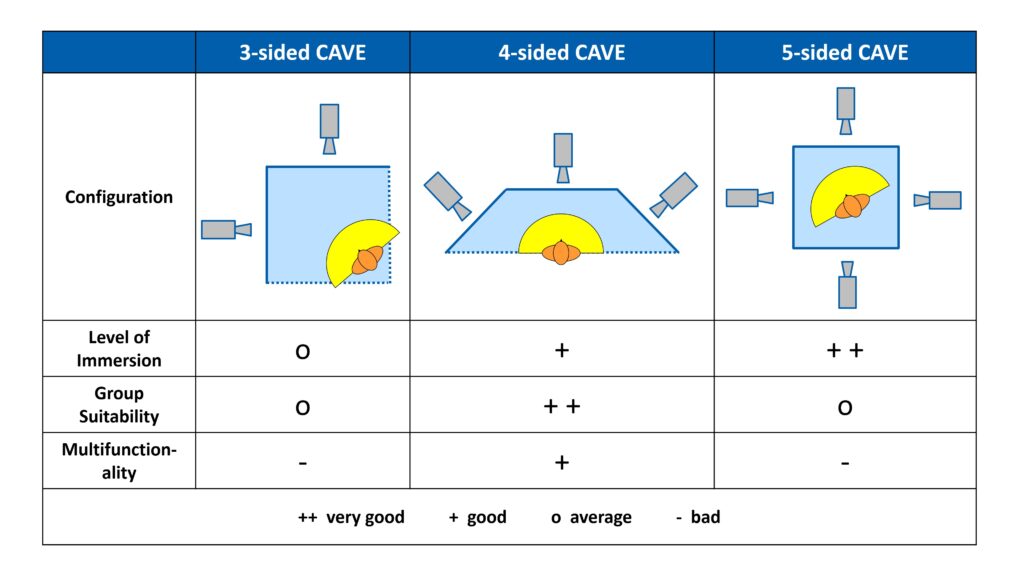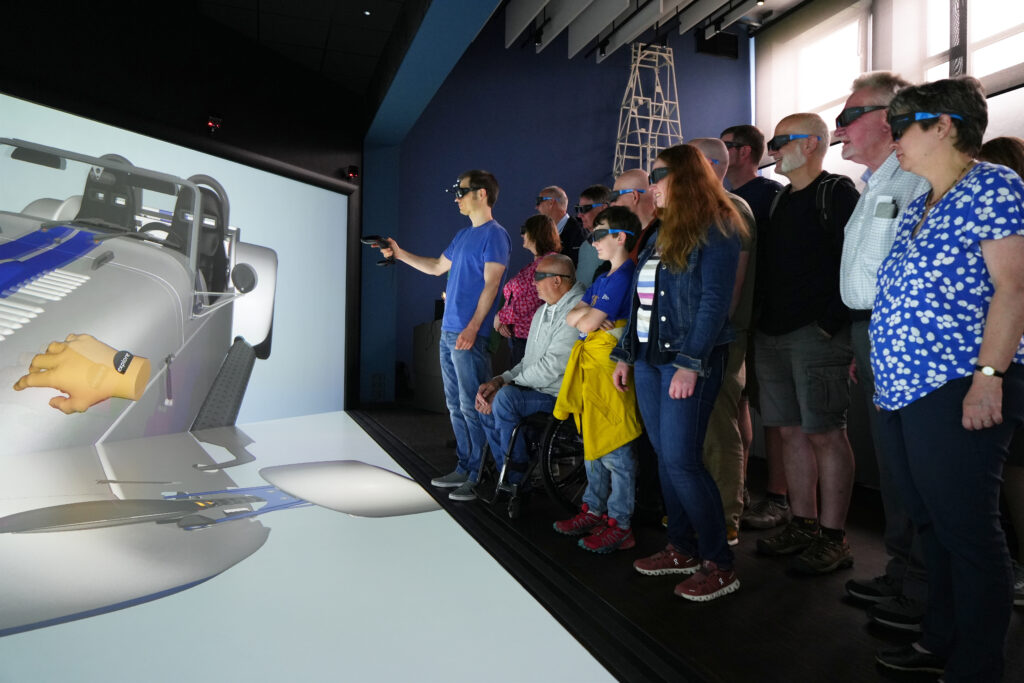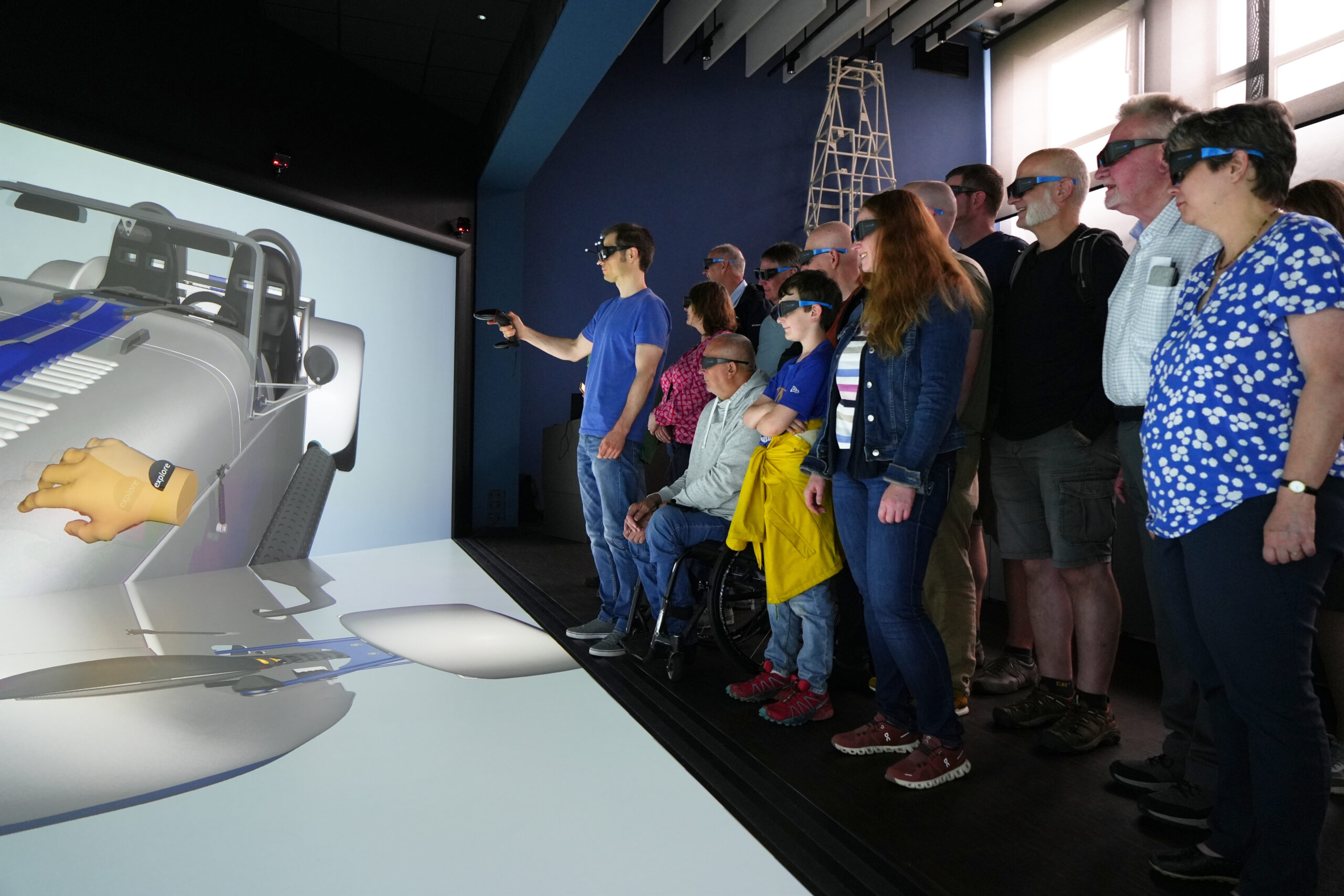by Wilhelm Hannibal, South Westphalia University of Applied Sciences in Iserlohn, Germany.
Conception of the CAVE
A 4-sided CAVE system has been in operation at the South Westphalia University of Applied Sciences in Iserlohn since 2023. An unfolded version was chosen for the arrangement of the projection screens, in which three 8 mm thick glass panes are used as projection surfaces with dimensions of 4 by 2.5 meters (see middle of Figure 1). The projection surfaces are each illuminated by a three-chip laser projector.

Figure 1: CAVE concepts for system selection
In addition to the rear projection of the 3 screens, 2 additional projectors are used, whereby the two light cones hit the floor between the right and left screens via mirrors as a fourth projection surface. This arrangement of the projection surfaces is suitable for allowing up to 10 people to participate in the VR experience at the same time, see Figure 2. The immersion is also excellent with the 5 projectors.

Figure 2: CAVE presentation of the Lotus Super Seven with a group of about 12 people
The CAVE concept is mainly used for applications in engineering training in the field of mechanical engineering. The CAVE area is connected to a lecture hall with 30 seats, Figure 3.

Figure 3: Projection room of the 4-sided CAVE with attached lecture hall
The system’s media control is equipped with different presentation modes. This allows you to spontaneously switch between 3D CAVE operation and normal presentations at any time. Up to three different presentations can be shown on the projection surfaces at the same time. This enables normal lecture hall operation for lectures, with VR models only being used occasionally to support the course. The utilisation of this lecture hall with the CAVE area was successful in the first year of use with around 100 events.
Various groups of people used the system or lecture hall during this period. These include professors and students with their own 3D CAD models as well as employees of the university administration and industry representatives.
CAVE Applications
3D models from different CAD software solutions are prepared for VR operation via an interface using the IC.IDO software from ESI Group. The software can also be used for head-mounted displays (HMD), so that VR models can be created outside the CAVE, which are only used later in the CAVE.
Figure 4 lists examples that are used in published courses in the mechanical engineering department. On the left is a vehicle – Lotus Super Seven – that has been reconstructed as a CAD model to around 95 % over the last 10 years. The level of detail is so high that the complex geometries can be made quickly understandable to students in VR CAVE operation. The second example shows a section of a combustion engine. With this CAD model, kinematic simulations can also be transferred directly from IC.IDO via the CAVE interface. And the model on the right in Figure 4 is an oil pump test bench for optimizing the friction of oil pumps. In the CAVE, all components of the test bench can be penetrated, which is not possible on the real test bench.

Figure 4: Design examples for VR-CAVE operation
Benefits of using CAVE applications in engineering education
Since only about 30 % of all people have a very good spatial imagination, the CAVE application offers an excellent opportunity to convey very complex geometries to the viewer quickly and comprehensibly through excellent immersion.
The communication is particularly successful with the chosen CAVE concept with the unfolded projection screens in groups of people. Newly developed products can also be presented very well to a broad audience that does not only consist of technicians. When the geometries are penetrated, for example with sections through components, complex components and processes become more understandable. With a head-mounted display, only one person can use the VR technology and communication within a group is severely limited. There is also the risk of getting dizzy, which is generally referred to as “motion sickness”.
Another valuable use of the large screens is video conferences, since the people involved can be shown accordingly large, or many people can be visible in the video conference.
Challenges in CAVE operations
To operate VR models in a CAVE, you need to be appropriately trained. Without this expertise, CAVE operation is not possible. Occasionally, problems occur that need to be resolved. This also requires appropriate expertise.
Conclusion
With the new CAVE technology and the connected lecture hall at the University of Applied Sciences Südwestfalen, there are opportunities to explore complex components with several people at the same time using VR methods. Courses become more effective and students are motivated with these new pedagogical methods to create their own VR models. Social relationships between students are promoted. Projects can also be implemented better in teamwork. Work is underway to create more useful VR models in order to further develop the quality of engineering training. It can be assumed that VR technology will continue to develop, both in the area of CAVE and in the area of head-mounted display technology.
In the future, simulation methods will be more integrated into CAVE operations. Opening up the facility to industrial projects is desired so that companies can use these options in their development of innovative products.
The technology can also be used for medical purposes or for architectural applications.

Author
Professor Dr.-Ing. Wilhelm Hannibal
South Westphalia University of Applied Sciences in Iserlohn, Germany.
Professor Dr.-Ing. Wilhelm Hannibal studied mechanical engineering at the University of Hanover, graduated in 1986 // Designer for combustion engines at Audi, team leader for pre-development of multi-valve technology and technical calculation // 1993 PhD from the University of Stuttgart // 1993 Project manager for V8 gasoline engine // 1995 Head of technical calculation in Neckarsulm // Since August 1995 Professor for design theory and CAx training at the University of Applied Sciences in Iserlohn // Spokesperson for the Automotive Engineering course // 2001 Founded enTec Consulting as co-owner and managing director // 2019 Entry into VR applications with head-mounted displays and initiator of the CAVE in Iserlohn














